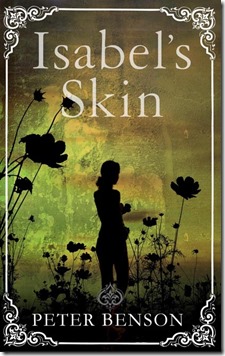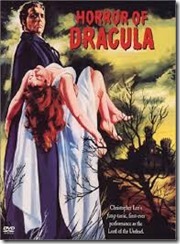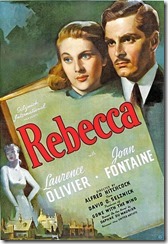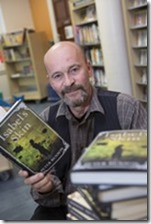
All changes, even the most longed for, have their melancholy; for what we leave behind us is a part of ourselves; we must die to one life before we can enter another. – Anatole France
This is an historical novel but it really doesn’t need to be and most of the time I was reading it I forgot when it was set. It was only when a horse and cart appeared rather than a car that I was reminded. This is not a criticism. It simply underlines the timeless quality of the work. Actually it’s quite typical of the kind of story that Hammer Films would’ve been interested in adapting in the sixties—perhaps as a follow-up to The Reptile—and if they’d only read half the book they’d have probably jumped at the chance to bid for it. Of course once they’d got their hands on it they’d have ripped out 90% of it, beefed up the horror angle and rewritten the ending probably lopping off the whole last section which would’ve been a crying shame because there’s actually something worthwhile going on here.
Alma Books describe Benson’s new novel as follows:
Peter Benson’s new novel is a slick Gothic tale in the English tradition, a murder mystery and a tour of Edwardian England. More than this, it is a work of atmosphere and unease which creates a world of inhuman anxiety and suspense.
It’s a fair description but also a little misleading; there, for example, is no mystery about the murder (there’s invariably a murder in a gothic novel) as we get to witness it. It does, however, borrow heavily from the popular tropes/motifs attached to Gothic fiction:
The setting is greatly influential in Gothic novels. It not only evokes the atmosphere of horror and dread, but also portrays the deterioration of its world. The decaying, ruined scenery implies that at one time there was a thriving world. At one time the abbey, castle, or landscape was something treasured and appreciated. Now, all that lasts is the decaying shell of a once thriving dwelling.
The Gothic hero becomes a sort of archetype as we find that there is a pattern to their characterization. There is always the protagonist, usually isolated either voluntarily or involuntarily. Then there is the villain, who is the epitome of evil, either by his (usually a man) own fall from grace, or by some implicit malevolence. The Wanderer, found in many Gothic tales, is the epitome of isolation as he wanders the earth in perpetual exile, usually a form of divine punishment.
The plot itself mirrors the ruined world in its dealings with a protagonist's fall from grace as she succumbs to temptation from a villain. In the end, the protagonist must be saved through a reunion with a loved one. – The Gothic Novel, David De Vore, Anne Domenic, Alexandra Kwan and Nicole Reidy, University of California
Benson’s hero, David Morris, isn’t quite as charismatic as your bog-standard Byronic hero—he’s really not the slightest bit charismatic…
I lived the life of an average bachelor, settled into what I thought was comfort, inured to the city, dreaming of something else but not sure what, lost in work and habits and the conventions that cloaked my work.
 …although Hammer would’ve probably (mis)cast Peter Wyngarde in the part—but he comes to realise through the course of the novel that he’s more flawed and conflicted than he might’ve admitted at the start and also discovers that he isn’t beyond acting in ways that could be considered morally questionable as long as it gets the job done.
…although Hammer would’ve probably (mis)cast Peter Wyngarde in the part—but he comes to realise through the course of the novel that he’s more flawed and conflicted than he might’ve admitted at the start and also discovers that he isn’t beyond acting in ways that could be considered morally questionable as long as it gets the job done.
The villain, Professor Richard Hunt, appears at first to be very much your run-of-the-mill mad scientist although we never do get to see his laboratory. This is how Morris describes him in part:
His hand was ice-cold, his skin was too smooth for a man of his age and his face had a sucked-in, skeletal look. His hair was dark and thin and combed carefully over the crown of his balding head. I guess he must have been sixty, but he could have been forty-five.
[…]
I assumed he was English, but an edge to his accent made me think he was German, maybe, or Austrian. His eyes were grey and cunning and looked straight into mine.
 Baron Frankenstein isn’t a mad scientist in the book although he was completely off his trolley once Hammer had finished with him; Shelley makes her character more rounded and his mental instability more subtly portrayed. Hunt, like Frankenstein, is not a bad man but his obsession with forbidden knowledge has driven him over the edge or at least that’s how it seems because we never get to sit him down with a nice cup of tea and talk to him; it’s too late in the game for that. (Hammer would’ve been courting Donald Pleasence for the part I’m sure.)
Baron Frankenstein isn’t a mad scientist in the book although he was completely off his trolley once Hammer had finished with him; Shelley makes her character more rounded and his mental instability more subtly portrayed. Hunt, like Frankenstein, is not a bad man but his obsession with forbidden knowledge has driven him over the edge or at least that’s how it seems because we never get to sit him down with a nice cup of tea and talk to him; it’s too late in the game for that. (Hammer would’ve been courting Donald Pleasence for the part I’m sure.)
The monster is every bit as articulate as Frankenstein’s creation and only driven to extreme actions by extreme circumstances. I can’t say any more about it without ruining the book. Some suspension of disbelief wouldn’t be out of place though.
 There is, too, the obligatory love interest (Jane Asher maybe?) but (thankfully) Benson’s women don’t spend all their time screaming and swooning even if they are a tad tamer than their twenty-first century counterparts. She is trapped, though, and it falls on Morris to rescue her and more than once. There’s also a housekeeper although she’s much more Mrs Hughes (Downton Abbey) than Mrs Danvers (Rebecca).
There is, too, the obligatory love interest (Jane Asher maybe?) but (thankfully) Benson’s women don’t spend all their time screaming and swooning even if they are a tad tamer than their twenty-first century counterparts. She is trapped, though, and it falls on Morris to rescue her and more than once. There’s also a housekeeper although she’s much more Mrs Hughes (Downton Abbey) than Mrs Danvers (Rebecca).
The setting of the Gothic Novel is a character in itself. The plot is usually set in a castle, an abbey, a monastery, or some other, usually religious edifice, and it is acknowledged that this building has secrets of its own. It is this gloomy and frightening scenery, which sets the scene for what the audience should expect. – Wikipedia
The old dark house, Belmont Hall, is nowhere near as dark and gloomy as it might’ve been despite the build-up it gets from the neighbours. An urchin Morris encounters on his way to Ashbrittle wants to know where he’s headed and when he’s told the lad doesn’t have much good to say about the place:
“Wouldn’t go there. Not like it is.”
“What do you mean?”
“There’s bad things there.”
“Bad things? What do you mean?”
He shook his head, looked at his black, calloused feet and hitched up his trousers. “Ma says there’s bad things in Ashbrittle. Crawling things. Evil, she says.”
“Evil? What sort of evil?”
“The screaming kind,” he says. “Ma says you can hear her in the night time. Sometimes in the day too.”
If it is a character in the novel it’s only a bit player. It’s certainly not alive (as in The Fall of the House of Usher) or menacing but it does provide a setting where we can look inside the hero’s head: the only scenes of importance in the building are in the library; Morris is a book-valuer and he’s there to appraise a collection of original editions by authors of the French Enlightenment and this is the one room in the house he should feel at home so in that respect it conforms with the gothic tradition of providing vital insight into the hero’s character. What’s interesting about The Fall of the House of Usher is that the house does double duty—it’s both setting and monster—and Benson pulls off a similar trick in his book but that’s all I’m saying on that score. Only a fraction of the novel takes place at Belmont Hall anyway and nothing major. The house in which he writes down his story is probably more important:
[T]his is my house at the edge of the marshes with its roof, floors and chairs, and there go a flock of geese, and this is my house too. It is like everyone’s other house, a place where secrets, promises, dreams and terrors are kept. Mine is like this.
It is not a lasting state, this house, but it changes every day. It holds things that never leave – the memory of the first time I saw her, the sound of her cries echoing in the night, the smell of her sweat, the feel of her – and it grows, twists and adds things to itself.
It could be mad or it could be angry, or it could double back on itself and become taller than the tallest building in a city you visited once and wish you could see again. It could be yellow and black and talk in a language only it understands. It could whisper about careless times, or flare like a candle and become the person you loved, someone who took your life and wrenched it away. Her name could chime, and when you are so lonely and you pull her image from an envelope and stare at it in the middle of the night you know she was the love of your life and you will never forget her. You can smell her skin, the skin that hurt so much, but then the smell passes. It has gone, and before you have a chance, you find yourself screaming in the night and wailing into the day.
 The storyline in a gothic novel is frequently presented by means of a series of secret manuscripts or multiple tales—Dracula is a good example—but that’s not the case here. Here we have one narrator looking back at these life-changing events from some time in the future but there are three stories: the main tale, the visit to Somerset, the encounter with the madman, the rescue of the girl (the consequences of which are dealt with when the action moves to London and subsequently Norfolk); the story of Morris’s friend Timothy who he met in Edinburgh whilst at university and who he runs into again briefly in London (wonder if Benson was looking to cast Timothy as the wanderer archetype?) and the story of Morris’s relationship with his father who happens to be a clergyman and so that covers that motif. The book features flashbacks heavily—essentially the whole novel is a flashback and so we have flashbacks within a flashback—and although they flesh out the character of Morris they also serve to disguise a rather thin main plotline which might bother some readers; me, I think plot’s overrated.
The storyline in a gothic novel is frequently presented by means of a series of secret manuscripts or multiple tales—Dracula is a good example—but that’s not the case here. Here we have one narrator looking back at these life-changing events from some time in the future but there are three stories: the main tale, the visit to Somerset, the encounter with the madman, the rescue of the girl (the consequences of which are dealt with when the action moves to London and subsequently Norfolk); the story of Morris’s friend Timothy who he met in Edinburgh whilst at university and who he runs into again briefly in London (wonder if Benson was looking to cast Timothy as the wanderer archetype?) and the story of Morris’s relationship with his father who happens to be a clergyman and so that covers that motif. The book features flashbacks heavily—essentially the whole novel is a flashback and so we have flashbacks within a flashback—and although they flesh out the character of Morris they also serve to disguise a rather thin main plotline which might bother some readers; me, I think plot’s overrated.
There’s no magic in the book—nothing supernatural at all—although there are a few dreams. It mixes elements of the classic gothic horror with historical romances, the psychological thriller and also the bildungsroman because our hero does a lot of growing up in these 269 pages.
The novel is prefaced by a quote:
We shall not all sleep, but we shall all be changed. – 1 Corinthians 15:51
It is a recurring theme throughout the book:
[W]hat are our lies and imaginings? Is one the lie of the idea that you can never change? The lie of a father’s religious truth? The lie of one man’s myths? And are the imaginings telling of a sweet and perfect love, one moored to a solid stone quay? One with sweet voices in the morning and the smell of woodsmoke drifting in still air?
There are a lot of questions in the book; more questions than I think I’ve ever read in a novel and most unanswered. The quote above comes from a whole page filled with questions. Inevitably Morris is changed by what happens to him and what he has to do. At the end of the book he writes:
I am different now, changed. I do not imagine I am clever, and I do not think I am pleased. When I remember things I have done and places I have known, I realize I was never true to them or true to myself. I spent too much time lost between what I thought made me happy and the ideas of happiness that were fed to me. But happiness only comes when you stop playing games and realize the only thing you have is your state of mind. This is all there is, nothing more.
I said this book was a gothic horror and a romance and a thriller but it’s also a literary novel. A lot of time is spent in introspection and this does slow down the action considerably as do the lengthy descriptions that Benson is famous for and, let’s give the man credit, damn good at; his descriptions of the house are nothing to write home about but once he gets into his element outside he comes into his own:
The moon was swollen, and its full light gave the land a flat, endless look. The wood was a rash across the side of the hill, and the tops of the trees gashed the skyline. The cats were prowling and ran from me as I crossed the drive and jumped the gate into the orchard, and then I was under the apple trees and past the chicken coop. The hens scratched and rustled their wings. A fox was near. I smelt it and as I turned my nose to the scent, I heard a howl.
I’m not a big fan of long (or even short) descriptive passages but I do like introspection and I suppose before everything else I’ve just mentioned this book is first and foremost a character study.
Structurally the novel’s a slow burner; it picks up towards the middle and we’re left to rake through the ashes at the end. It’s framed by a prologue and an epilogue and at first I thought there’d been a printing error because the epilogue reads so like the prologue:
Prologue: I wrote this story in a wooden house at the bottom of a thin garden. Turn your back on the sea, cross the lawn, walk past the bushes, the flower beds and the pond with the statue of a dog. Stop, take a deep breath and look.
Epilogue: I wrote this story in my low house at the bottom of a small garden. Turn your back on the marshes, cross the lawn, go past the trees and flowers, and the pond with the reeds and frogs.
This continues for a couple of pages. Of course they’re different but I found the technique quite compelling. You can read the entire prologue here. It really is interesting reading basically the same text a second time once you know what’s happened. Very clever. That said, I felt he said a little too much in the prologue and some of my assumptions proved right; I think I would’ve rather not had my head pointed in certain directions too soon.
 The problem the novel has—although how much of a problem this will pose will depend on a) how well-read the reader is and b) how much they care about these things—is that it’s not one thing nor t’other: it’s not Frankenstein and it’s not Rebecca. Nor is it Jane Eyre (i.e. no madwoman in the attic) although I did think for a bit that it might head off in that direction. And it’s not Poe. I wouldn’t go as far as saying this is a pastiche—it rankled me when a reviewer referred to my novel Milligan and Murphy as a pastiche—so I’m not going to do that to someone else, although a couple of other reviewers have. Benson tips his hat to everyone from Horace Walpole on but this book is very much his; the gothic is a skin that is shed by the end of the book and that’s only right and proper because this is a book about transformation. Love is what changes Morris but this is not the kind of love that one would expect had this novel been written at the time during which it’s set. I appreciated that. Love’s complex and too many novelists do it a disservice, attaching an on/off switch to it or making it some kind of panacea. Saving the girl shouldn’t guarantee getting the girl. I can say no more without spoiling the ending but if you’re looking for boy meets girl, saves girl, loses girl, saves girl properly this times and lives happily ever after with girl then think again. The literary device of the gothic novel was an interesting choice but it’s also a bit distracting and I know I wasn’t the only reader who went through ticking off the clichés as I read. On the whole I liked it though and actually think it might be a far better book than some reviewers have judged it; it just needs a second read wherein you’re not focusing on the plot.
The problem the novel has—although how much of a problem this will pose will depend on a) how well-read the reader is and b) how much they care about these things—is that it’s not one thing nor t’other: it’s not Frankenstein and it’s not Rebecca. Nor is it Jane Eyre (i.e. no madwoman in the attic) although I did think for a bit that it might head off in that direction. And it’s not Poe. I wouldn’t go as far as saying this is a pastiche—it rankled me when a reviewer referred to my novel Milligan and Murphy as a pastiche—so I’m not going to do that to someone else, although a couple of other reviewers have. Benson tips his hat to everyone from Horace Walpole on but this book is very much his; the gothic is a skin that is shed by the end of the book and that’s only right and proper because this is a book about transformation. Love is what changes Morris but this is not the kind of love that one would expect had this novel been written at the time during which it’s set. I appreciated that. Love’s complex and too many novelists do it a disservice, attaching an on/off switch to it or making it some kind of panacea. Saving the girl shouldn’t guarantee getting the girl. I can say no more without spoiling the ending but if you’re looking for boy meets girl, saves girl, loses girl, saves girl properly this times and lives happily ever after with girl then think again. The literary device of the gothic novel was an interesting choice but it’s also a bit distracting and I know I wasn’t the only reader who went through ticking off the clichés as I read. On the whole I liked it though and actually think it might be a far better book than some reviewers have judged it; it just needs a second read wherein you’re not focusing on the plot.
This is the third book I’ve read by Peter Benson. I wasn’t crazy about Two Cows and a Vanful of Smoke but I could see he had something and so I volunteered to review The Levels when it was rereleased as an ebook; it was much better and so I was looking forward to Isabel’s Skin when I heard he had a new book coming out and would happily read him again.
There’s an interesting article on Benson in The Independent here. Apparently he’s busy writing the third in what he calls his "loose Ashbrittle trilogy". Can’t really see the scope for a series but you never know with writers; I killed off my protagonist at the end of my first novel and still managed a sequel with him in it.
***
 Born in 1956, Peter Benson was educated in Ramsgate, Canterbury and Exeter. His first novel, The Levels (which I reviewed here), won the Guardian Fiction Prize. This was followed by A Lesser Dependency, winner of the Encore award and The Other Occupant, which was awarded the Somerset Maugham Award. He has also published short stories, screenplays and poetry, some adapted for TV and radio and many translated into other languages. His latest work is a play co-authored with Alessandro Gallenzi, The Two Friends, a theatrical retelling of Gogol’s famous story of the two Ivans squabbling over a trifling insult.
Born in 1956, Peter Benson was educated in Ramsgate, Canterbury and Exeter. His first novel, The Levels (which I reviewed here), won the Guardian Fiction Prize. This was followed by A Lesser Dependency, winner of the Encore award and The Other Occupant, which was awarded the Somerset Maugham Award. He has also published short stories, screenplays and poetry, some adapted for TV and radio and many translated into other languages. His latest work is a play co-authored with Alessandro Gallenzi, The Two Friends, a theatrical retelling of Gogol’s famous story of the two Ivans squabbling over a trifling insult.

No comments:
Post a Comment